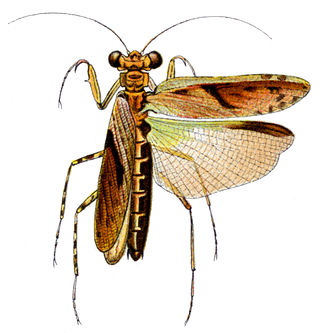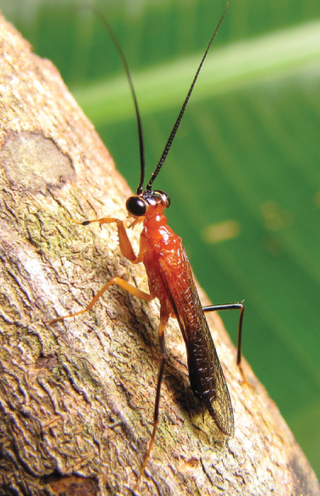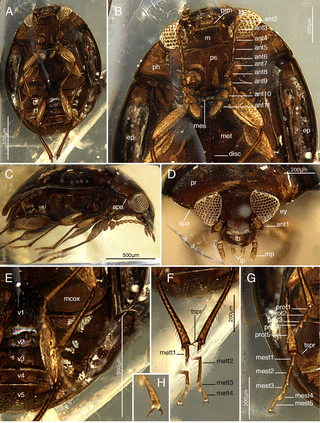
Chaeteessidae is a family of praying mantises. It contains a single extant genus, Chaeteessa, native to South America which is thought to be the most primitive and earliest diverging lineage of living mantises. Fossil genera are known from the Paleogene of Eurasia and North America.

Amorphoscelidae is a family of mantises in the order Mantodea.

Belidae is a family of weevils, called belids or primitive weevils because they have straight antennae, unlike the "true weevils" or Curculionidae which have geniculate (elbowed) antennae. They are sometimes known as "cycad weevils", but this properly refers to a few species from the genera Parallocorynus and Rhopalotria.

Alexandr Pavlovich Rasnitsyn is a Russian entomologist, expert in palaeoentomology, and Honored Scientist of the Russian Federation (2001). His scientific interests are centered on the palaeontology, phylogeny, and taxonomy of hymenopteran insects and insects in general. He has also studied broader biological problems such as evolutionary theory, the principles of phylogenetics, taxonomy, nomenclature, and palaeoecology. He has published over 300 articles and books in several languages. In August 2008 he was awarded the Distinguished Research Medal of the International Society of Hymenopterists.

The Cerophytidae are a family of beetles belonging to Elateroidea. Larvae are associated with rotting wood, on which they are presumed to feed. The family contains over 20 species in five genera, primarily distributed in the New World, but also in Eurasia and Africa. 17 fossil species in 7 genera are known extending to the Early Jurassic. Like some other elateroids, the adults are capable of clicking.

Cryptophagidae is a family of beetles with representatives found in all biogeographic realms. Members of this family are commonly called silken fungus beetles and both adults and larvae appear to feed exclusively on fungi although in a wide variety of habitats and situations, such as rotting wood and shed animal fur and feathers. These beetles vary from about 1 to 11 millimeters long, and usually have an oval body shape with a slight "waist".

Vadim Gennadyevich Gratshev was one of world leading experts in palaeoentomology. Vadim graduated from the Moscow State Pedagogical Institute in 1987 and taught biology at a high school for three years until 1989. Then he decided to pursue academic science and joined the Laboratory of Arthropods at the Paleontological Institute of Russian Academy of Sciences in 1991, first as a Kuperwood Fellow of the Academy of Natural Sciences, and since 1994 as a full-time researcher. Weevils and dryopoids were always his main passion, although his area of interests extended far beyond that. He produced over 20 scientific papers, including an outstanding comparative study of the hindwing venation of the superfamily Curculionoidea published in co-authorship with Vladimir Zherikhin. Being a keen field researcher, he participated in numerous expeditions to the Maritime Province and Sakhalin Island, Kuznetskii Alatau, Novosibirsk Region, Armenia, Azerbaijan, Georgia, Tajikistan, Turkmenia, and Ukraine. The material he collected on his trip to the Drakensberg and Zululand in 2005 inspired him to commence a new project on Afrotropical Elmidae and Anthribidae. Being an optimistic, cheerful multi-talented individual with subtle sense of humour, he did not restrict his interests to extinct and extant beetles. He was an expert in noble orchids, aquarium design and raising geckos, and published several papers on those topics. He was a skillful wood-carver, and his knowledge of Japanese history and literature was not amateur.

Nemonychidae is a small family of weevils, placed within the primitive weevil group because they have straight rather than geniculate (elbowed) antennae. They are often called pine flower weevils. As in the Anthribidae, the labrum appears as a separate segment to the clypeus, and the maxillary palps are long and projecting. Nemonychidae have all ventrites free, while Anthribidae have ventrites 1-4 connate or partially fused. Nemonychidae lack lateral carinae on the pronotum, while these are usually present, though may be short, in Anthribidae.
Eobelinae are an extinct weevil subfamily that throve in the late Mesozoic. They belong to the family Nemonychidae. The Eobelidae were widespread, occurring at least in Central Asia, Spain and Brazil during the Late Jurassic and Early Cretaceous.

Mantises are an order (Mantodea) of insects that contains over 2,400 species in about 460 genera in 33 families. The largest family is the Mantidae ("mantids"). Mantises are distributed worldwide in temperate and tropical habitats. They have triangular heads with bulging eyes supported on flexible necks. Their elongated bodies may or may not have wings, but all Mantodea have forelegs that are greatly enlarged and adapted for catching and gripping prey; their upright posture, while remaining stationary with forearms folded, has led to the common name praying mantis.

Mantoididae is a family of praying mantises which contains Neotropical species of praying mantises from tropical North and South America. The family was formerly represented by the sole genus Mantoida, until the genus Paramantoida was described in 2014 and Vespamantoida in 2019. The family differs from the closely related Chaeteessidae in having an apical claw on the fore tibiae which are also less curved. Males have ocelli and a cylindrical body shape, unlike the dorsoventrally flattened Chaeteessidae. The cerci are also shorter.
Vladimir Vasilevich Zherikhin, of the Paleontological Institute, Russian Academy of Sciences, Moscow, was one of the world's leading paleoentomologists and coleopterists. He worked on the palaeontology of the Coleoptera (beetles) and of insects in general, and on the taxonomy of the weevils (Curculionoidea).

Burmese amber, also known as Burmite or Kachin amber, is amber from the Hukawng Valley in northern Myanmar. The amber is dated to around 100 million years ago, during the latest Albian to earliest Cenomanian ages of the mid-Cretaceous period. The amber is of significant palaeontological interest due to the diversity of flora and fauna contained as inclusions, particularly arthropods including insects and arachnids but also birds, lizards, snakes, frogs and fragmentary dinosaur remains. The amber has been known and commercially exploited since the first century AD, and has been known to science since the mid-nineteenth century. Research on the deposit has attracted controversy due to its alleged role in funding internal conflict in Myanmar and hazardous working conditions in the mines where it is collected.

New Jersey Amber, sometimes called Raritan amber, is amber found in the Raritan and Magothy Formations of the Central Atlantic (Eastern) coast of the United States. It is dated to the Late Cretaceous, Turonian age, based on pollen analysis of the host formations. It has been known since the 19th century, with several of the old clay-pit sites now producing many specimens for study. It has yielded a number of organism fossils, including fungi, plants, tardigrades, insects and feathers. The first identified Cretaceous age ant was described from a fossil found in New Jersey in 1966.

Cyclaxyridae are a family of beetles in the superfamily Cucujoidea. The only living genus is Cyclaxyra, with two species endemic to New Zealand. Other species have been named from fossils. They are also known as sooty mould beetles due to the association of Cyclaxyra with sooty mould. The extant species are mycophagous, feeding on spores, conidia, and hyphae.
Baissomantis is an extinct genus of mantises in the family Baissomantidae. There are two described species of Baissomantis both of which are known from the Early Cretaceous Zaza Formation of Buryatia, Russia.
Baissomantidae is an extinct family of primitive mantises known from the Cretaceous period. There are two known genera, Baissomantis, known from the Early Cretaceous Zaza Formation of Buryatia, Russia, and Labradormantis from the mid Cretaceous (Cenomanian) Redmond Formation of Labrador, Canada. They are amongst the most primitive mantises known, only more advanced than Santanmantis.

Santanmantis is an extinct genus of mantises, the sole genus in the family Santanmantidae. The only species, Santanmantis axelrodi, is known from the Crato Formation of Brazil, dating to the late Aptian stage of the Early Cretaceous. It is amongst the most primitive known lineages of mantis. Like other mantises, the forelegs are modified into spined raptorial appendages. When describing a new specimen in 2017, Hörnig, Haug and Haug proposed that the second set of legs also had spines similar to the forelegs, and also served a raptorial function, but that they were not visible in the fossil due to being broken off. However a response to this paper criticised this assumption, finding that it had little evidence from the fossil itself or from living mantises.

Elcanidae are an extinct family of Mesozoic and early Cenozoic orthopterans. Members of the family are distinguished by the presence of spurs on the distal part of the metatibia, unique among orthopterans, these have been suggested to have been used for controlling gliding, swimming aids, or for jumping on water. The group combines characteristics from both major groups of orthopterans, with long antennae and nymphal morphology similar to Ensifera, but with wing venation and adult morphology more similar to Caelifera. Elcanidae is part of Elcanoidea, which is thought to have diverged from living orthopterans by the beginning of the Permian, around 300 million years ago. The family also includes Permelcanidae, known from the Early-Late Permian. The relationship of Elcanoidea to Ensifera and Caelifera is currently unresolved. Elcanids are known from the Late Triassic to Paleocene of Eurasia, North and South America. Some members of the group exhibited aposematic coloration.














